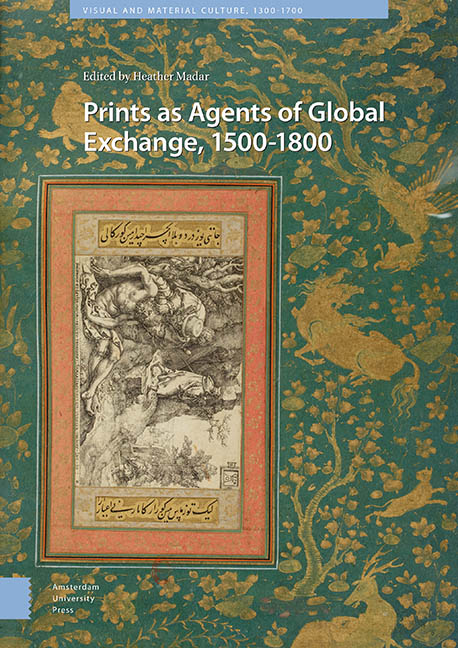Book contents
- Frontmatter
- Table of Contents
- List of illustrations
- Introduction
- 1 Concealing and Revealing the Female Body in European Prints and Mughal Paintings
- 2 The Sultan’s Face Looks East and West: European Prints and Ottoman Sultan Portraiture
- 3 From Europe to Persia and Back Again: Border-Crossing Prints and the Asymmetries of Early Modern Cultural Encounter
- 4 The Dissemination of Western European Prints Eastward: The Armenian Case
- 5 The Catholic Reformation and Japanese Hidden Christians: Books as Historical Ties
- 6 (Re)framing the Virgin of Guadalupe: The Concurrence of Early Modern Prints and Colonial Devotions in Creating the Virgin
- 7 Hidden Resemblances: Re-contextualized and Re-framed: Diego de Valadés’ Cross Cultural Exchange
- 8 The Practice of Art: Auxiliary Plastic Models and Prints in Italy, Spain, and Peru
- 9 Ink and Feathers: Prints, Printed Books, and Mexican Featherwork
- Index
1 - Concealing and Revealing the Female Body in European Prints and Mughal Paintings
Published online by Cambridge University Press: 16 December 2021
- Frontmatter
- Table of Contents
- List of illustrations
- Introduction
- 1 Concealing and Revealing the Female Body in European Prints and Mughal Paintings
- 2 The Sultan’s Face Looks East and West: European Prints and Ottoman Sultan Portraiture
- 3 From Europe to Persia and Back Again: Border-Crossing Prints and the Asymmetries of Early Modern Cultural Encounter
- 4 The Dissemination of Western European Prints Eastward: The Armenian Case
- 5 The Catholic Reformation and Japanese Hidden Christians: Books as Historical Ties
- 6 (Re)framing the Virgin of Guadalupe: The Concurrence of Early Modern Prints and Colonial Devotions in Creating the Virgin
- 7 Hidden Resemblances: Re-contextualized and Re-framed: Diego de Valadés’ Cross Cultural Exchange
- 8 The Practice of Art: Auxiliary Plastic Models and Prints in Italy, Spain, and Peru
- 9 Ink and Feathers: Prints, Printed Books, and Mexican Featherwork
- Index
Summary
Abstract
This essay explores how European female bodies as depicted in Western prints were re-contextualized in Mughal environments of the late sixteenth and early seventeenth centuries and reframed in Mughal paintings. Mughal patrons and artists drew on this body of visual material as they explored possibilities for fashioning Mughal models of female chastity and sensuality in service of the court. In addition to adapting various stylistic techniques and powerful symbols, this process involved locating synergies between Christian, European, Islamic, Timurid/Mughal, South Asian, and Hindu beliefs and practices. In this way, Mughal artists and their patrons cultivated links and located points of convergence between a variety of cultures and belief systems, an important characteristic of early Mughal rule.
Keywords: Mughal painting, Akbar, Jahangir, European prints, Pietas Regia
When the first Indo-Persian eyewitness accounts of visits to Europe appeared in the late eighteenth century, these male authors were taken aback by displays of physical intimacy between men and women in the public sphere. Such proximity was read as signaling the disintegration of ‘the moral and the immoral, and the decent and the indecent’ in European society. These texts, alongside those penned by Iranian Persian visitors to Europe, share perceptions of zan-i firangi (European women) as objects of their critical and objectifying scrutiny. By 1839, Indo-Persian accounts often tied the corrupting influence of European women's sexual immorality to the political threat embodied by Europe. Symbolically, European women came to represent the broader political and cultural conflicts between the East and West; as such, the female body became “an important metaphor for demarcating the self and the other.” For observers to identify the female body as a marker of cultural difference might not seem surprising, considering that European colonizers, including those who traveled to Muslim courts, had been engaging in a discourse about the “other” for a few centuries as an instrument of colonization. In contrast, however, these Indo-Persian first-person responses about European difference emerged comparatively late in the history of such East-West exchange, in response to the ever-increasing dominance of European colonial might that was taking shape throughout South Asia during the late eighteenth century.
- Type
- Chapter
- Information
- Prints as Agents of Global Exchange1500-1800, pp. 31 - 72Publisher: Amsterdam University PressPrint publication year: 2021



